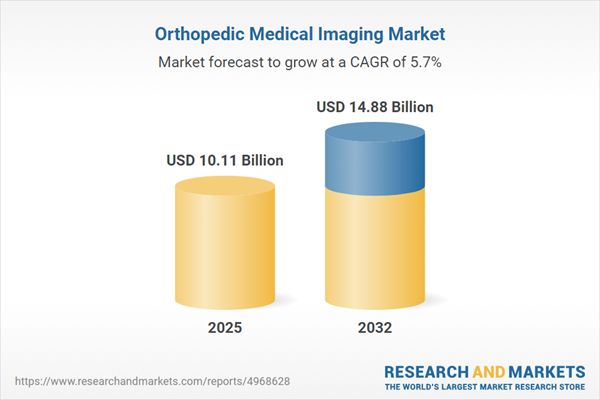Speak directly to the analyst to clarify any post sales queries you may have.
The orthopedic medical imaging market is adapting rapidly as healthcare providers adopt advanced technologies to meet rising clinical demands and evolving operational challenges. Senior decision-makers navigating this space need insight into the pivotal factors shaping competitive advantage, from technology convergence to global supply chain impacts and the emergence of intelligent diagnostics.
Market Snapshot: Orthopedic Medical Imaging Market Growth and Key Opportunities
The orthopedic medical imaging market grew from USD 9.57 billion in 2024 to USD 10.11 billion in 2025. It is expected to continue expanding at a CAGR of 5.66%, reaching USD 14.88 billion by 2032. This growth is fueled by increasing global demand for musculoskeletal diagnostics, innovations in imaging hardware and software, and a push for improved patient outcomes in both hospital and outpatient environments. Forward-thinking organizations are capitalizing on shifts toward data-driven care and interoperability, positioning themselves for long-term resilience and patient-centered excellence.
Scope & Segmentation
- Modality: CT (Cone Beam CT, Multi Slice CT), Fluoroscopy (Fixed, Portable), MRI (Closed, Open), Nuclear Imaging (PET, SPECT), Ultrasound (Cart-Based, Portable), X-Ray (Analog, Digital).
- Application: Imaging for Foot & Ankle, Hip, Knee, Shoulder, and Spine.
- End User: Ambulatory Surgical Centers, Clinics, Diagnostic Centers, Hospitals.
- Component: Consumables (Contrast Media, Films & Plates), Equipment, Software & Services (Maintenance, Training, Software).
- Technology: Three-Dimensional, Two-Dimensional imaging platforms with digital workflow integration.
- Regions: Americas (including United States, Canada, Mexico, Brazil, others), Europe, Middle East & Africa (United Kingdom, Germany, France, and more), Asia-Pacific (China, India, Japan, Australia, etc.).
- Major Companies: Siemens Healthineers AG, GE HealthCare Technologies Inc., Koninklijke Philips N.V., Canon Medical Systems Corporation, Fujifilm Holdings Corporation, Shimadzu Corporation, Konica Minolta, Inc., Agfa-Gevaert N.V., Carestream Health, Inc., Esaote S.p.A.
Key Takeaways for Decision-Makers
- Emerging technologies, particularly artificial intelligence and cloud-based analytics, are enhancing diagnostic accuracy, advancing surgical planning, and supporting personalized care pathways.
- Healthcare providers and manufacturers are restructuring operations and procurement strategies to withstand market volatility and optimize imaging equipment utilization.
- Regulatory changes, such as recent US tariffs, are prompting accelerated diversification of supply chains and a pivot toward localized manufacturing to mitigate risk.
- Increasing adoption of portable and point-of-care imaging platforms expands access in outpatient, ambulatory, and remote settings, responding to new reimbursement models and patient expectations.
- Value-based care initiatives are influencing investment in interoperability, automated reporting, and data-sharing platforms that streamline workflows and cost efficiencies.
- Training and upskilling programs for clinicians are pivotal for maximizing technology ROI and driving rapid integration of AI and advanced imaging tools into clinical routines.
Tariff Impact: Navigating 2025 Supply Chain Shifts
US tariff policies implemented in 2025 have caused manufacturers to reevaluate sourcing, accelerating moves toward alternative suppliers, regionalized production, and standardization of imaging components. Providers are leveraging long-term financing and strategic alliances to sustain access to critical systems amid fluctuating procurement costs. Organizations establishing diversified supplier relationships and agile inventory management strategies are best placed to maintain reliable equipment availability and patient care quality in a changing trade environment.
Methodology & Data Sources
This report utilizes a multistage approach combining interviews with industry leaders, clinical experts, and procurement professionals. Evidence is validated through regulatory filings, clinical studies, and expert panel reviews, supported by data triangulation and quality control measures to ensure accuracy and actionable insights.
Orthopedic Medical Imaging Market: Why This Report Matters
- Offers a comprehensive, segmented view of technology trends, clinical applications, and regional growth strategies to inform capital planning and competitive response.
- Enables stakeholders to anticipate the impact of regulatory changes and supply chain disruptions, fostering risk-mitigation strategies and resilient decision-making.
- Supports actionable investment decisions by highlighting how innovations in imaging and workflow integration translate to measurable improvements in patient care and operational efficiency.
Conclusion
The orthopedic medical imaging sector is entering a new era defined by advanced diagnostics, adaptive care models, and strategic supply chain realignments. Forward-looking organizations can drive growth and patient value by investing in intelligent technologies, collaborative partnerships, and workforce development aligned with evolving market dynamics.
Additional Product Information:
- Purchase of this report includes 1 year online access with quarterly updates.
- This report can be updated on request. Please contact our Customer Experience team using the Ask a Question widget on our website.
Table of Contents
3. Executive Summary
4. Market Overview
7. Cumulative Impact of Artificial Intelligence 2025
List of Figures
Companies Mentioned
The companies profiled in this Orthopedic Medical Imaging market report include:- Siemens Healthineers AG
- GE HealthCare Technologies Inc.
- Koninklijke Philips N.V.
- Canon Medical Systems Corporation
- Fujifilm Holdings Corporation
- Shimadzu Corporation
- Konica Minolta, Inc.
- agfa-Gevaert N.V.
- Carestream Health, Inc.
- Esaote S.p.A.
Table Information
| Report Attribute | Details |
|---|---|
| No. of Pages | 189 |
| Published | October 2025 |
| Forecast Period | 2025 - 2032 |
| Estimated Market Value ( USD | $ 10.11 Billion |
| Forecasted Market Value ( USD | $ 14.88 Billion |
| Compound Annual Growth Rate | 5.6% |
| Regions Covered | Global |
| No. of Companies Mentioned | 11 |









